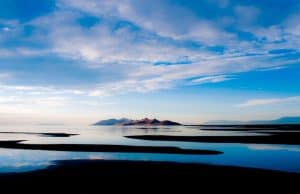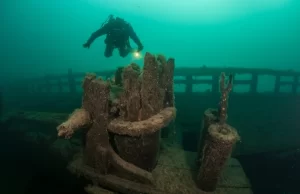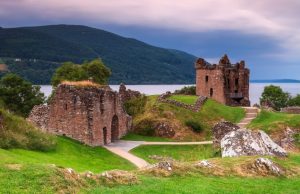This post contains affiliate links. If you click and purchase, we may earn a small referral fee at no extra cost to you. Read our full disclosure.
How did Earth’s natural lakes form? Receding glaciers and cataclysmic events such as earthquakes, volcanoes, and meteorite impact are some of the generally accepted geologic origins of our planet’s lakes. But the original inhabitants who lived around many popular vacation and recreation lakes had their own theories about creation.
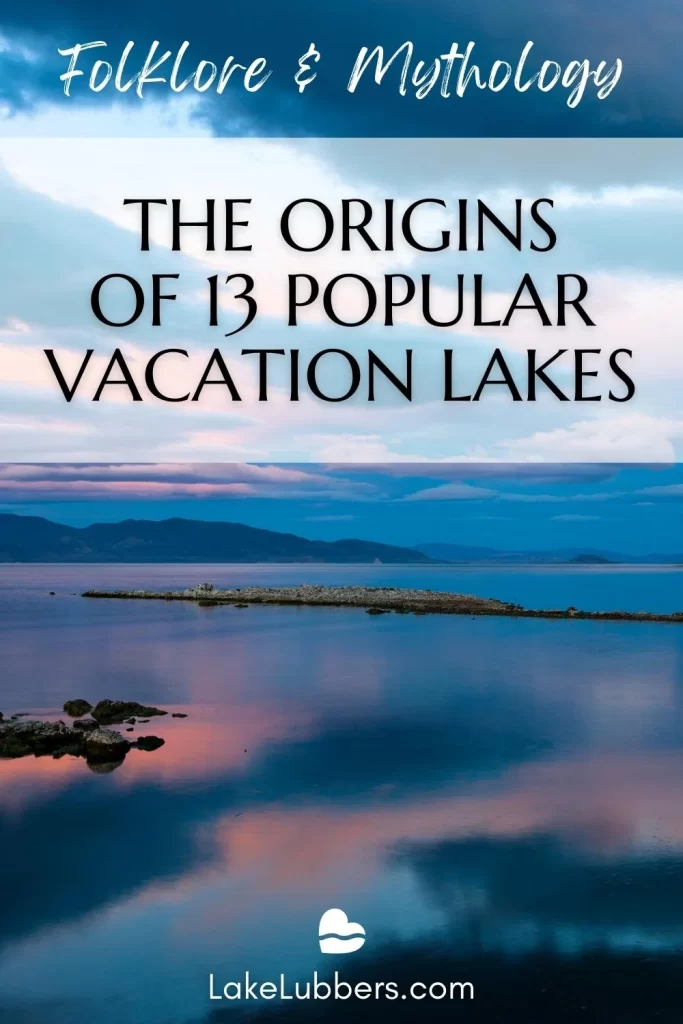
1 – Lake Wakatipu, New Zealand
New Zealand is a land of many spectacular lakes. Lake Wakatipu on the South Island is fuel for myths, a backdrop for Hollywood movies, and a vacation destination for adventure seekers.
The depths of Lake Wakatipu reach below sea level, where native people believe that a giant’s heart beats. This legend tells of the giant Matau who was burned to death in his sleep, as retaliation after kidnapping a chief’s daughter. The fire created a massive hole in the ground, melted the ice and snow on the surrounding mountains, and formed the lake.
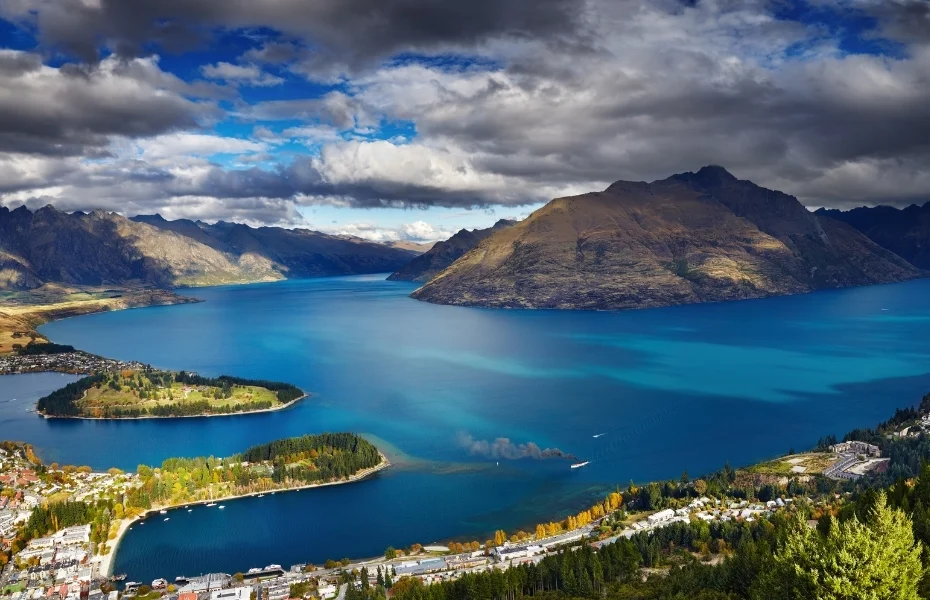
Lake Wakatipu, which means “hollow of the giant” in Maori, is shaped like a curled-up giant. The head rests at the north end of the lake in the town of Glenorchy. His knees are at Queenstown, and Matau’s feet are at the south end of the lake at Kingston.
The legend goes on to say that a giant’s heart cannot be destroyed, and that the beating of Matau’s heart causes the rise and fall of the water. (Science attributes the change in water levels to variations in atmospheric pressure.)

2 – Otter Lake, Ontario
Canada is packed with glacial lakes awaiting exploration. Otter Lake is a sparkling 1,252-acre lake near Parry Sound, Ontario, in the Georgian Bay region known as “The 30,000 Islands.” Georgian Bay is 200 miles long and 50 miles wide. Its surface covers 5,800 square miles.
Local legend tells of Kitchikewana, an ill-tempered god who was large enough to guard the entire Georgian Bay. In a fit of rage, Kitchikewana dug his hands into the ground and threw fists full of earth at the departing canoe of his true love, creating the 30,000 islands.
Whether formed by an angry god or massive glaciers, the Georgian Bay region is the crown jewel of the Great Lakes – and a fantastic spot for a vacation or second home.

3 – White Bear Lake, Minnesota
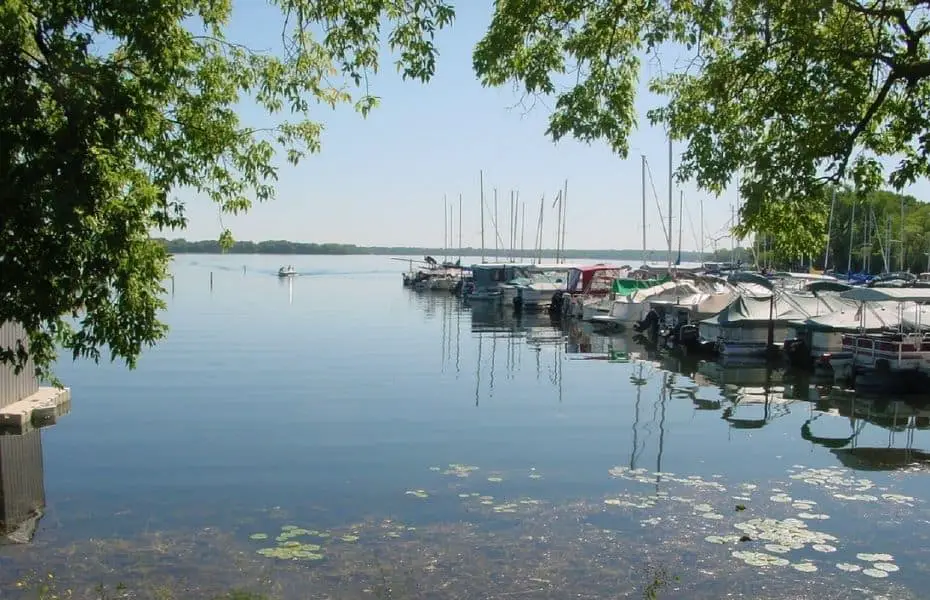
In Minnesota’s “Land of 10,000 Lakes,” White Bear Lake is a lakefront community conveniently located just north of Minneapolis-St. Paul.
Its earliest inhabitants were Dakota and Ojibway Native Americans who hunted and harvested the rich land and abundant wildlife. They named “White Bear Lake” in a legend that passed from generation to generation.
According to that legend, a Sioux maiden fell in love with a Chippewa brave. The two tribes were at war, so the two lovers met secretly on an island in the lake. One day as the brave approached the island, he saw a great white bear chasing her. He rushed to the maiden’s rescue, and she rushed to her father for help as the brave and bear fought.
As the maiden, her father, and several Sioux warriors approached the island, the Chippewa brave sank his knife into the bear as they both fell dead to the ground. Their spirits rose visibly from their dead bodies to forever wander the island.
A second version of the legend has the brave surviving the attack, the maiden’s father granting their marriage wish due to the bravery of the warrior, and their children playing happily on the skin of the great white bear. This second version was published in Mark Twain’s “Life on the Mississippi” in 1883.

4 – Lake Minnetonka, Minnesota
Lake Minnetonka, Minnesota, has inspired song, poetry, and legend for years. Minne is the Sioux word for water; Tonka translates as large and round.
Thurlow Lieurance based his song, “By the Waters of Minnetonka,” on a Native American legend. Henry Wadsworth Longfellow’s famous poem, “The Song of Hiawatha,” refers to landmarks near Minnetonka. And the beautiful lake was a prized spot for summer homes among many wealthy and famous people, including President Taft.
Sioux legend tells of an ill-fated love between Moon Deer, a daughter of the Moon Clan, and Sun Deer of the Sun Clan. Because tribal law forbade marriage between the two clans, the lovers ran away to Lake Minnetonka, only to encounter the Chippewa, enemies of the Sioux.
Fearing both the Chippewa and a return home, they took their own lives, disappearing between the waves. Many moons later when the Sioux drove the Chippewa from the shores of Lake Minnetonka, they heard a strange melody emanating from the waters. The spirits of Moon Deer and Sun Deer appeared as two lilies that grew to the sky in the light of the moon.
The lovers’ song can still be heard today in the rhythmic sounds of the waves and in the pines along Minnetonka’s shore.

10 Best Bass Fishing Lakes in the U.S. (2023)
Let’s be clear: There is no shortage of great bass fishing lakes in the United States. In fact, did you know you can locate the species in every state except Alaska? Yes,…

5 – Devil’s Lake, Wisconsin
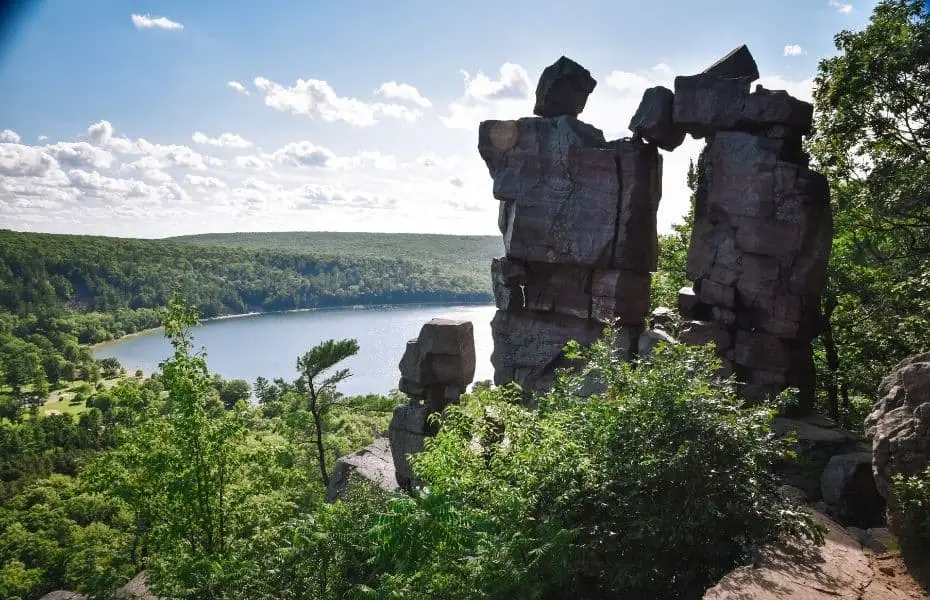
Spring-fed Devil’s Lake, Wisconsin, was formed thousands of years ago by a natural moraine dam (rock debris) deposited by retreating glaciers. Devils’ Lake is now part of the Ice Age National Scientific Reserve. But Native American legend tells a different tale of the lake’s creation.
The Ho-Chunk tribe prayed for new hunting grounds, and a giant green waterspirit was sent to the snow-covered land. The heat from the waterspirit’s body melted the snow and ice while he chewed away the ground to allow the water to flow off.
This noise drew the Ho-Chunk to the location, where they were blessed with a deep and beautiful lake with surrounding grassland. The Ho-Chunk lived near the lake for several years, but abandoned it when they heard unusual shrieks and cries heard during tribal celebrations, thought to come from the waterspirit itself.
They named the water “Holy Lake,” but a translation error years ago produced Devil’s Lake.

6 – Devils Lake, Oregon
Oregon, too, has a Devils Lake. Far from maleficent, Devils Lake is a sweet little wonder lying in the midst of Oregon’s attractive Lincoln City. The lake lies uniquely on Oregon’s Pacific Ocean coast, connected to the ocean via D River (yes, the letter “D”).
But names do carry their meanings, and Devils Lake’s less-than-sweet title was inspired by a legend of the American Indian Siletz people who once inhabited the area. According to Chief William Depoe, the Siletz encountered the bad spirits of the water during a celebration. A creature emerged to capture a group of warriors, pulling them down into the lake’s disrupted waters.
The spirits were eventually appeased, and the people showed respect by making offerings before crossing the lake. The events of the legend might be a little spooky, but the present-day lake’s attractive features lure visitors with a wide variety of recreational offerings.

7 – Lake Waccamaw, North Carolina
Lake Waccamaw in southeastern North Carolina is the second largest natural freshwater lake east of the Mississippi River. Local legend claims that Lake Waccamaw was once a huge mound of flowers, watched over by a beautiful Indian princess. A besotted Indian brave asked the princess to marry him but she refused, leading to a war between the local tribes.
Rather than marry the brave and give up her flowers, the princess chose to die on the spot and turned the flowers into a huge lake. A legend perhaps, but locals claim that there is still a spot where no flowers will grow.
Scientists estimate that Lake Waccamaw was formed around 250,000 years ago, although its origin is uncertain. One theory is that the lake basin was formed after a peat fire in prehistoric times. Old charred tree stumps have been found to support this theory.
Another theory claims that meteorites formed Lake Waccamaw and a group of lakes known as the Bladen Lake Group; all of these lakes are oval and angled in the same way.
Located 40 miles west of Wilmington, N.C., Lake Waccamaw and Lake Waccamaw State Park can be enjoyed year round.

8 – Pyramid Lake, Nevada
Pyramid Lake is a true natural wonder located in the Pyramid Lake Paiute Indian Reservation in western Nevada. It is one of five remaining salt lakes in the United States. Local Paiute Indians control the lake, but it is open to the public for fishing and recreation.
Pyramid Lake gets its name from the unusual Tufa rock formations found there. On the eastern shore of Pyramid Lake sits a large pyramid shaped stone Tufa called Stonemother. According to Paiute legend, she is the mother of their people, and of all other Native Americans.
Her husband, the father of her children, separated all of their children into different tribes when they would not stop bickering. The mother was so sad that she sat and wept, creating Pyramid Lake. She sat so long that she turned to stone, and she still sits by the lake today.

9 – Spirit Lake, Iowa
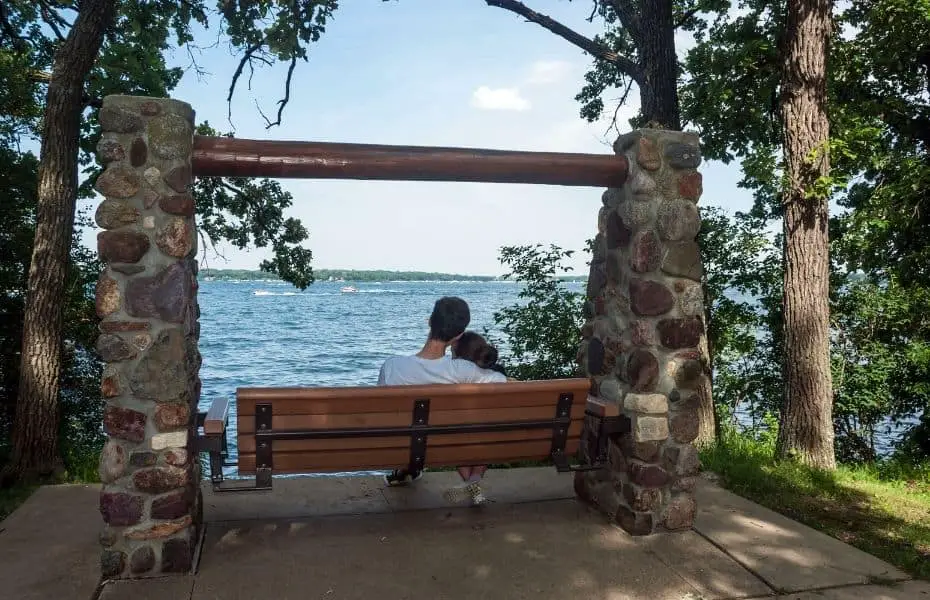
Spirit Lake is one lake in a chain of glacial lakes known as Iowa Great Lakes. Also called Big Spirit Lake, this natural body of water was named by Dakota Native Americans who believed that the lake was guarded by evil spirits.
Because of this legend, the Dakota did not cross Big Spirit Lake in canoes, and early settlers to the area found no evidence of Native American canoes around the lake. The lake was named “Minnewaukon” by Native Americans and Lac D’Esprit by French explorers – both translating to “Lake of Spirits.”
Spirit Lake is Iowa’s largest natural lake, a remnant of the most recent ice age, 13,000 years ago. Today, Spirit lake is a popular vacation and retirement destination.

10 – Lake Crescent, Washington
Lake Crescent is a majestic glacial lake located at the northern tip of the Olympic National Forest in Clallam County, Washington. Glaciers during the last ice age carved a deep valley in the Olympic Mountains through which Indian Creek flowed.
A massive landslide 8,000 years ago dammed the creek, creating Lake Crescent. The lake is nestled serenely at the base of Mount Storm King, an imposing peak rising 4,500 feet from the shoreline.
Local native legend claims that Mount Storm King grew tired of fighting between the Clallam and Quileute tribes, so he threw giant rocks to stop the warring. The rocks created the deep depression that is now Lake Crescent – so deep that its bottom lies below sea level.

11 – Lake Sanabria, Spain
Lake Sanabria is Spain’s largest lake. Although scientists say it was formed by glaciers, locals tell a more colorful tale.
According to legend, the village of Valverde de Lucerna was located exactly where Lake Sanabria is today. One cold winter night, Jesus, disguised as a beggar in ragged clothes, came to the village starving and begging for food. The men of the village ran him off as they did not want his kind in their village.
As he was leaving, some women in a bakery took pity on the man and gave him some bread still warm from their oven. The beggar told the women to rush to the nearby mountains, and then he took his staff and drove it into the ground, commanding water to rise from the hole.
Water gushed from the hole, drowning the village and all the men, until the lake was formed. All that remained of the village were the kind-hearted women and the roof top of the bakery, which is now said to form the little island in the center of Lake Sanabria.
Today, visitors are captivated by breathtaking views, lush green mountains, and inviting natural beaches.

12 – Lake Trasimeno, Italy
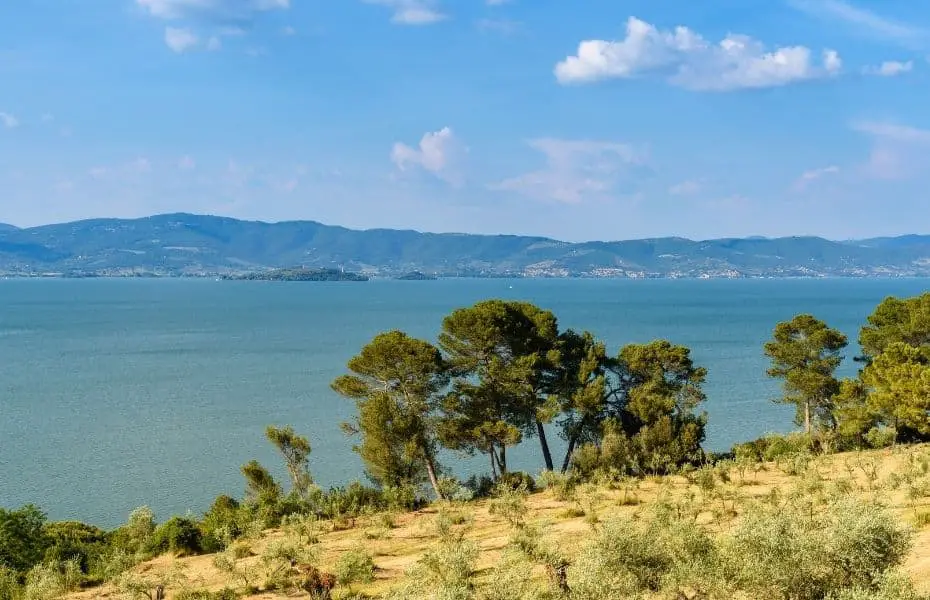
Italy’s most famous lakes, such as Lake Como and Lake Maggiore, are located in the northern Lombardy region near the Swiss border. Other popular vacation lakes are scattered throughout Italy. Umbria’s Lake Trasimeno, situated in the heart of Italy, provides a rich history, great panoramic views, and a wealth of recreational offerings.
Three islands in Lake Trasimeno can be visited by ferry. Isola Minore is uninhabited. Isola Polvese is a nature reserve with the ruins of an old monastery. The third, Isola Maggiore, is home to fishermen, lace knitters and a great legend.
In 1211, according to legend, a fisherman gave Saint Francis a pike from his fresh catch. Saint Francis threw the pike back into the water, and the grateful fish followed him around the lake until the saint dispensed a special blessing to the fish.
This legend is commemorated at the island’s church as a reminder of Saint Francis and “Brother Fish.” Today, freshly-caught pike and other fish are used in local dishes, creating culinary delights when cooked with local olive oil, wines, and herbs over a wood fire.

13 – Band-e Amir Lakes, Afghanistan
Afghanistan now has its first national park, and the major attraction is Band-e-Amir Lakes. Once a popular tourist attraction, this chain of six brilliant blue lakes is seen as the promise of a brighter future for a country marred by decades of war.
Local tradition holds that Band-e Amir Lakes were formed by the miraculous act of Ali, cousin and son-in-law of the Prophet Mohammed. The story has many variations, but in each Ali appears in the disguise of a slave before a tyrannical infidel king.
Challenged by the king to control the raging Band-e Amir River, Ali swings his sword cutting off a mountain top to create the first lake, Band-e Zulfiqar. Ali then digs up trees and shrubs, building a dam that creates Band-e Pudina. Local women bring him cheese used in yet another attempt to dam the water, resulting in the white-bottomed Band-e Panir.
Finally, Ali hurls rocks and boulders that form Band-e Haibat, and ultimately controls the river. Upon success of the miraculous feat, Ali reveals his identity and the king converts to Islam on the spot.
A shrine commemorating Ali’s miracle and recited prayers was erected in 1904 and remains along the sacred shore of Band-e Haibat. While still a destination for the daring and adventuresome, Band-e-Amir Lakes is welcoming thousands of visitors every year.
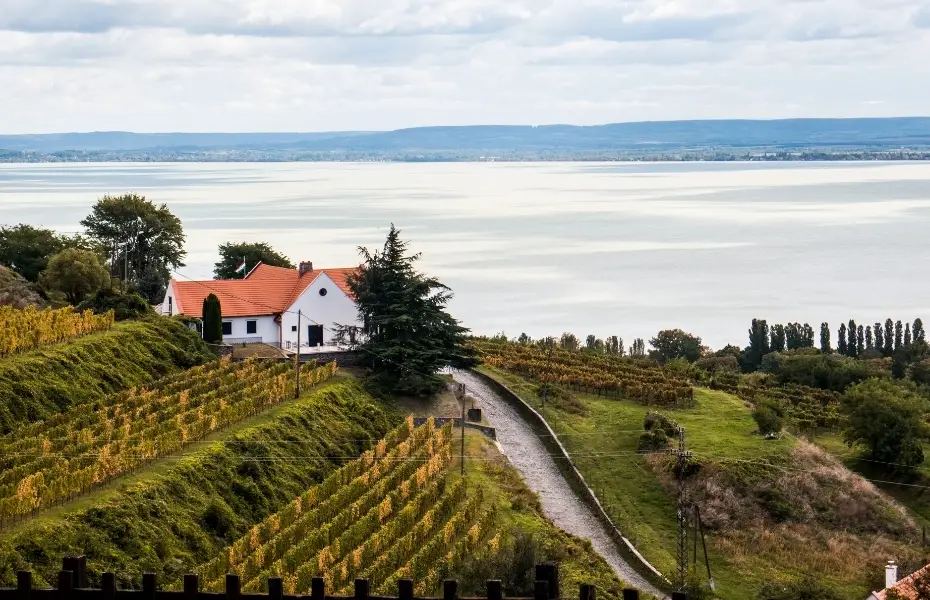
5 International Lakes Perfect for Wine Lovers
The only thing better than a lake vacation is a lake vacation in wine country. After a day out on the water you can settle down to a glass of local red…

